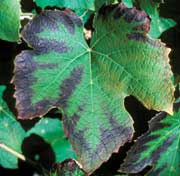Agiorgitiko
| Agiorgitiko | |
|---|---|
| Grape (Vitis) | |
 | |
| Color of berry skin | Noir |
| Species | Vitis vinifera |
| Also called | Aghiorghitiko, Mavro Nemeas, St. George, and other synonyms |
| Origin | Nemea |
| Notable regions | Greece |
| VIVC number | 102 |
Agiorgitiko (
One of the more commercially important
The red wine produced from the grape is characteristically spicy with notes of
Agiorgitiko is generally planted in dry, infertile soil to encourage the production of fewer but more concentrated grapes, ripening after mid-September.[2]
History

The name Agiorgitiko means literally "St. George's grape" which could be a reference to the chapel of
The main land owners in Nemea was the church and the monks from St George monastery of Feneos would tend to the vineyards and harvest the grapes to make wine at the monastery for communion. This is another theory of the naming of the St George wine is after the St George monastery of Feneos.
Viticulture
Agiorgitiko tends to produce small clusters of small, thick-skinned berries. The vine is

The grape is a late
Wine expert
New clones
For most of the 21st century, growers have been working with Greek wine authorities to produce new virus-free clones of Agiorgitiko that have the potential to resist most grape disease, including botrytis bunch rot, and produce small berries with thicker skins that could ripen to higher sugar levels with most consistent yields. In 2012, several of these new clones were released to Greek wine growers who have slowly begun replanting their Agiorgitiko vineyards.[1]
Wine regions

In 2012, Agiorgitiko was the most widely planted red grape variety in Greece with 5,202 hectares (12,850 acres) in Attica, 3,204 hectares (7,920 acres) in Peloponnese and additional plantings in Macedonia and
According to Master of Wine Jancis Robinson, some of the "most serious examples" of Agiorgitiko come from the higher altitude vineyards (up to 900 metres (3,000 ft)) of the Asprokampos plateau around Nemea and in the hills (between 500 metres (1,600 ft) to 600 metres (2,000 ft)) around Koutsi in Corinthia.[1]
Styles

Agiorgitiko is a very versatile grape variety that can be made in a wide range of styles from light rosés to soft, fruity reds made by
The small berries and thick skins of the grape contribute to high phenolic levels of Agiorgitiko which leads the wine needing very little
According to wine expert
According to the Wine & Spirit Education Trust (WSET), the best examples of Agiorgitiko tend to have moderate to low acidity, with a deep, ruby color, red fruit aromas and a sweet spicy note. These examples tend to come from vineyards planted in the middle range of the hillside slopes around Nemea with grapes harvested near the top of the 900 metres (3,000 ft) hills being excessively acidic while those harvested from the very warm valley floor often being too "jammy". The variance in quality of Agiorgitiko from the different vineyards around Nemea have led some Greek wine producers to investigate developing a cru classification system.[11]
Unlike the Xinomavro-based wines of fellow OPAP region Naousa, the wine experts at WSET note that the Agiorgitiko-based wines of Nemea tend to have a more "international style" which may enhance the potential of Greek wines on the international market.[11]
Synonyms
Over the years, Agiorgitiko has been known under various synonyms including: Aghiorghitico, Aigeorgitiko, Mavro (Black or Dark), Mavro Nemeas (in Nemea), Mavronemeas, Mavrostaphylo Mavraki, Mavroudi Nemeas, Nemeas Mavro, Nemeas Mavroudi and Saint George.[12]
References
- ^ ISBN 978-1-846-14446-2
- ^ ISBN 1-84000-897-0.
- ISBN 0-19-860990-6.
- ISBN 0-15-100714-4.
- ^ David Rosengarten "WINE AT THE TABLE New Greek Pitch: No Resin" Newsday, October 16th, 1991
- ^ Derek Gatopoulos "Popular Greek Wine Is Rained Out for the Year" Los Angeles Times, November 24th, 2002
- ^ ISBN 0-316-72654-0
- ^ Nestor Imports "Greek Grape Varietals Archived 2014-06-04 at the Wayback Machine" Accessed: June 15th, 2013
- ^ ISBN 1-56305-434-5
- ^ ISBN 9780756686840
- ^ ISBN 9781905819157
- ^ Agiorgitiko Archived 2011-07-19 at the Wayback Machine, Vitis International Variety Catalogue, accessed on June 21, 2010
